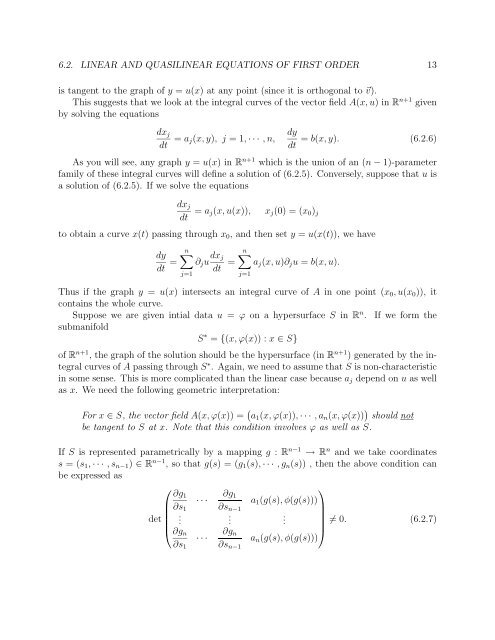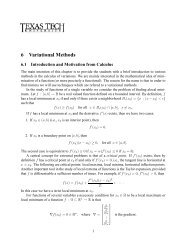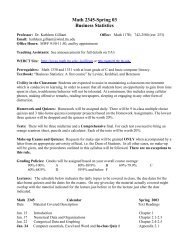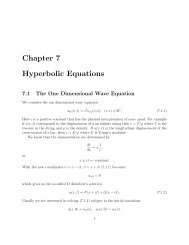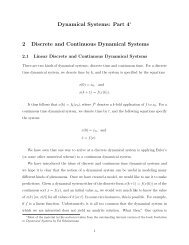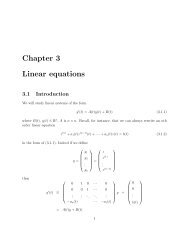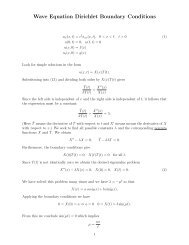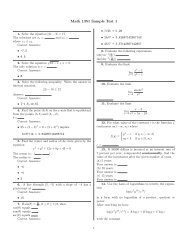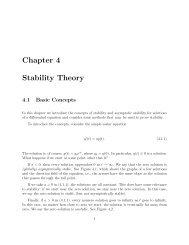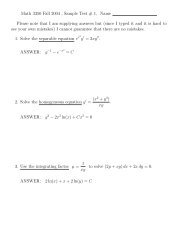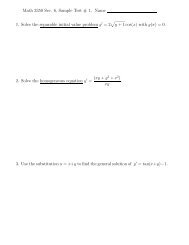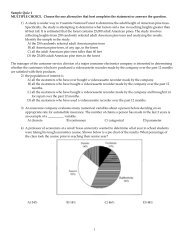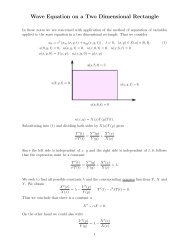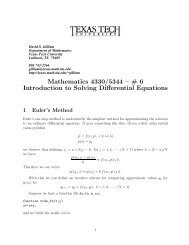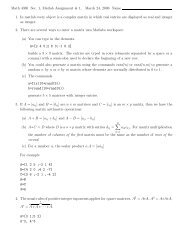Chapter 6 Partial Differential Equations
Chapter 6 Partial Differential Equations
Chapter 6 Partial Differential Equations
You also want an ePaper? Increase the reach of your titles
YUMPU automatically turns print PDFs into web optimized ePapers that Google loves.
6.2. LINEAR AND QUASILINEAR EQUATIONS OF FIRST ORDER 13<br />
is tangent to the graph of y = u(x) at any point (since it is orthogonal to ⃗v).<br />
This suggests that we look at the integral curves of the vector field A(x, u) inR n+1 given<br />
by solving the equations<br />
dx j<br />
dt = a j(x, y), j=1, ··· ,n,<br />
dy<br />
dt<br />
= b(x, y). (6.2.6)<br />
As you will see, any graph y = u(x) inR n+1 which is the union of an (n − 1)-parameter<br />
family of these integral curves will define a solution of (6.2.5). Conversely, suppose that u is<br />
a solution of (6.2.5). If we solve the equations<br />
dx j<br />
dt = a j(x, u(x)),<br />
x j (0)=(x 0 ) j<br />
to obtain a curve x(t) passing through x 0 , and then set y = u(x(t)), we have<br />
dy<br />
dt =<br />
n∑<br />
j=1<br />
∂ j u dx j<br />
dt =<br />
n∑<br />
a j (x, u)∂ j u = b(x, u).<br />
j=1<br />
Thus if the graph y = u(x) intersects an integral curve of A in one point (x 0 ,u(x 0 )), it<br />
contains the whole curve.<br />
Suppose we are given intial data u = ϕ on a hypersurface S in R n . If we form the<br />
submanifold<br />
S ∗ = {(x, ϕ(x)) : x ∈ S}<br />
of R n+1 , the graph of the solution should be the hypersurface (in R n+1 ) generated by the integral<br />
curves of A passing through S ∗ . Again, we need to assume that S is non-characteristic<br />
in some sense. This is more complicated than the linear case because a j depend on u as well<br />
as x. We need the following geometric interpretation:<br />
For x ∈ S, the vector field A(x, ϕ(x)) = ( a 1 (x, ϕ(x)), ··· ,a n (x, ϕ(x)) ) should not<br />
be tangent to S at x. Note that this condition involves ϕ as well as S.<br />
If S is represented parametrically by a mapping g : R n−1 → R n and we take coordinates<br />
s =(s 1 , ··· ,s n−1 ) ∈ R n−1 , so that g(s) =(g 1 (s), ··· ,g n (s)) , then the above condition can<br />
be expressed as<br />
⎛<br />
⎞<br />
∂g 1 ∂g 1<br />
··· a 1 (g(s),φ(g(s)))<br />
∂s 1 ∂s n−1<br />
det<br />
⎜ . .<br />
.<br />
⎟ ≠0. (6.2.7)<br />
⎝∂g n ∂g n<br />
⎠<br />
··· a n (g(s),φ(g(s)))<br />
∂s 1<br />
∂s n−1


